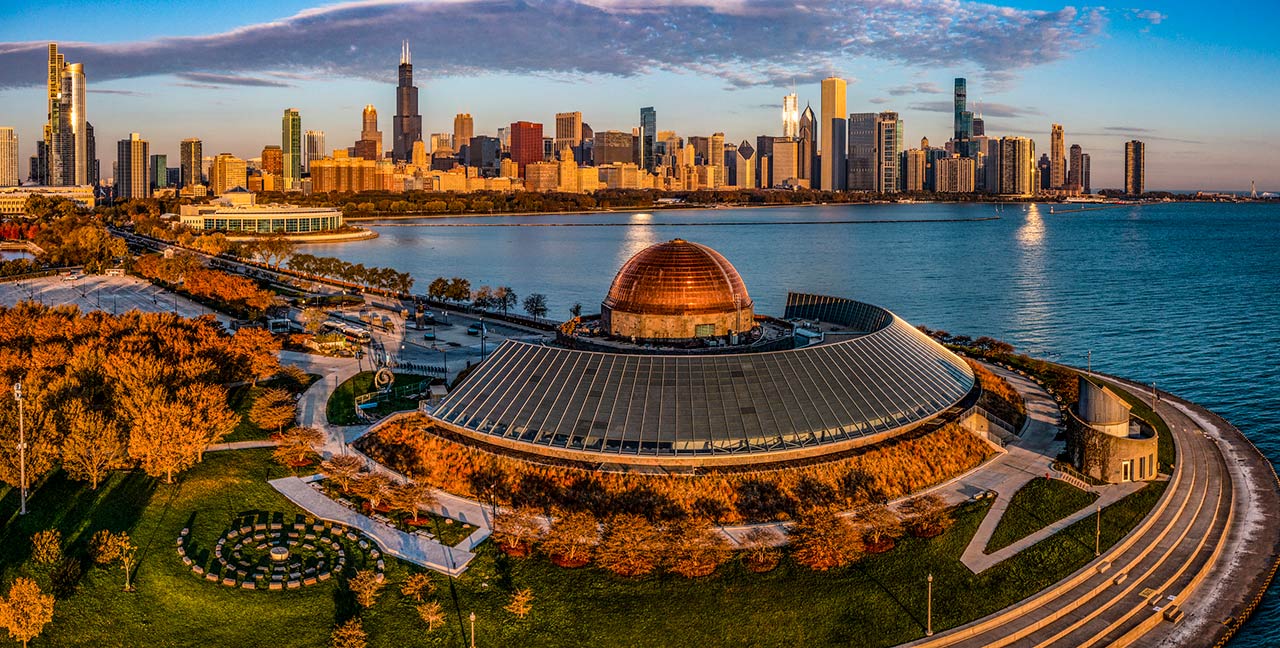Neighborhood News—Starry, Starry Nights (and days!) at the Adler Planetarium

“The Adler Planetarium connects people to the universe and each other.”
Next to Los Angeles ‘ Griffith Observatory, the Adler Planetarium is likely the best -known Planetarium in the United States. Located on the northeastern tip of Northerly Island on Lake Michigan, the Adler Planetarium was the first planetarium in the United States. Its domed presence rising high above Lake Michigan’s waters at 1300 S. DuSable Lake Shore Drive.
According to Wikipedia sources, the Planetarium began as the vision of Max Adler, a recently retired Sears, Roebuck & Co. executive and philanthropist. Adler listened to a friend describe a Munich planetarium. He decided that a planetarium would fit in well within the emerging ‘Museum Campus’ (Field Museum of Natural History, Shedd Aquarium).
Adler visited the Munich planetarium with his cousin, architect Ernest Grunsfeld Jr.. Adler then commissioned Gruenfeld to design the Chicago structure. At the same time, Adler learned about a sale of astronomical instruments and antiques by W. M. Mensing in Amsterdam, which he purchased the following year. The Mensing Collection became the focus of the then-called ‘Astronomical Museum’. Adler offered $500,000 in 1928 for the construction of the first planetarium in the Western Hemisphere, and on The Adler Planetarium opened to the public on Adler’s birthday, May 12. Phillip Fox, Ph.D., a professor of astronomy at Northwestern University, is appointed the Planetarium’s first director
What was space exploration like in the 1930’s? The history of exploring the universe dates back to the earliest centuries. Still, there was no NASA at the time. Clyde Tombaugh had just discovered Pluto (in 1930). There were only very large telescopes and curious scientists that had gone before, like Sir Isaac Newton’s theory of gravity in the 18th Century, Albert Einstein’s 1916 theory of relativity, Robert Goddard’s rocketry in its infancy, and 1910’s Ritchey-Chrétien telescope to inform us of Earth’s orbits and planets in the solar system. It took until 1947 for Chuck Yeager to break the sound barrier. The Adler Planetarium grew up, along with the era of rocket and ultimately, space exploration.
Today…
The Adler has three theaters, space science exhibitions, Including the Gemini 12 space capsule, and a collection of antique scientific instruments and print materials. In addition, the Adler Planetarium hosts the Doane Observatory, a research-active public observatory incorporating interactive displays into 60,000 square feet of exhibitions while showing mind-blowing sky shows (produced in-house) that take you above and beyond the stars via stellar 30-minute space adventures. Adler Planetarium For Kids
The Adler Planetarium accommodates the experience for people of all ages. While there are plenty of exhibits and shows that are perfect for the entire family, there are specific exhibits designed to give children an adventure of their very own.
‘Adler at Night’ on Wednesdays: special programs, honored guests
Every Wednesday is free museum entry for Illinois residents with proof of residency. Their Wednesday hours, from 4:00 pm–10:00 pm, are the perfect time for “hands-on, minds-on activities, experiences, and shows about the universe that will blow your mind,“ guaranteed! On Wednesday, December 14, a very special ‘Adler at Night,’ is planned, where you can meet scientists from around the country from 6pm–9pm, as part of the American Geophysical Union’s fall conference. Experts from the NASA Heliophysics Education Activation Team (NASA HEAT), the Center for Geospace Storms (CGS), NASA DRIVE Center, and the Interstellar Mapping and Acceleration Probe (IMAP) programs, among many others, will be on hand to provide their expertise. Book your tickets for December 14 or any future Adler at Night now by clicking here.
Alison Moran-Powers and Dean’s Team Chicago

